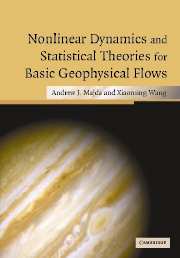Book contents
- Frontmatter
- Contents
- Preface
- 1 Barotropic geophysical flows and two-dimensional fluid flows: elementary introduction
- 2 The response to large-scale forcing
- 3 The selective decay principle for basic geophysical flows
- 4 Non-linear stability of steady geophysical flows
- 5 Topographic mean flow interaction, non-linear instability, and chaotic dynamics
- 6 Introduction to information theory and empirical statistical theory
- 7 Equilibrium statistical mechanics for systems of ordinary differential equations
- 8 Statistical mechanics for the truncated quasi-geostrophic equations
- 9 Empirical statistical theories for most probable states
- 10 Assessing the potential applicability of equilibrium statistical theories for geophysical flows: an overview
- 11 Predictions and comparison of equilibrium statistical theories
- 12 Equilibrium statistical theories and dynamical modeling of flows with forcing and dissipation
- 13 Predicting the jets and spots on Jupiter by equilibrium statistical mechanics
- 14 The statistical relevance of additional conserved quantities for truncated geophysical flows
- 15 A mathematical framework for quantifying predictability utilizing relative entropy
- 16 Barotropic quasi-geostrophic equations on the sphere
- Index
5 - Topographic mean flow interaction, non-linear instability, and chaotic dynamics
Published online by Cambridge University Press: 30 November 2009
- Frontmatter
- Contents
- Preface
- 1 Barotropic geophysical flows and two-dimensional fluid flows: elementary introduction
- 2 The response to large-scale forcing
- 3 The selective decay principle for basic geophysical flows
- 4 Non-linear stability of steady geophysical flows
- 5 Topographic mean flow interaction, non-linear instability, and chaotic dynamics
- 6 Introduction to information theory and empirical statistical theory
- 7 Equilibrium statistical mechanics for systems of ordinary differential equations
- 8 Statistical mechanics for the truncated quasi-geostrophic equations
- 9 Empirical statistical theories for most probable states
- 10 Assessing the potential applicability of equilibrium statistical theories for geophysical flows: an overview
- 11 Predictions and comparison of equilibrium statistical theories
- 12 Equilibrium statistical theories and dynamical modeling of flows with forcing and dissipation
- 13 Predicting the jets and spots on Jupiter by equilibrium statistical mechanics
- 14 The statistical relevance of additional conserved quantities for truncated geophysical flows
- 15 A mathematical framework for quantifying predictability utilizing relative entropy
- 16 Barotropic quasi-geostrophic equations on the sphere
- Index
Summary
Introduction
In this chapter we continue to study the dynamic behavior of the barotropic quasi-geostrophic equations in the absence of dissipation and external forcing, paying special attention to the non-linear interaction of the large-scale mean flow and the small-scale flow through topographic stress. Situations of obvious importance in atmosphere and ocean science occur when smaller-scale motions have a significant feedback and interaction with a larger-scale mean flow. One prototype situation of this sort occurs in the interaction of large-scale and small-scale components of barotropic flow over topography via topographic stress. In two influential papers, Charney and DeVore (1979) and Hart (1979) studied the multiple equilibrium states of this system with dissipation and single mode topography, and suggested their possible importance as model states for atmospheric blocking (see also Carnevale and Frederiksen, 1987; Vallis, 1985 for further developments).
In oceanography, in the special case of single mode topography as well as damping and driving, these equations have been used as a model for large-scale mean flow modification through topographic stress for flow along a continental shelf with smaller-scale topographic ridges (Allen etal., 1991; Samelson and Allen, 1987); also recently Holloway (Holloway, 1987; Edy and Holloway, 1994) has emphasized the possible dynamical significance of topographic stress in modifying coastal currents in many oceanographic contexts.
- Type
- Chapter
- Information
- Publisher: Cambridge University PressPrint publication year: 2006



